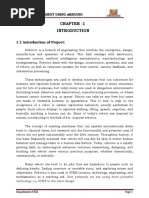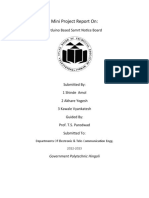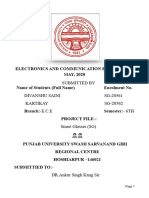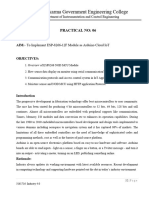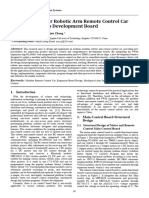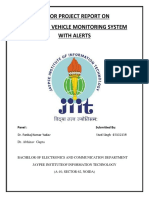Final Mini Project Documentation (VBNB)
Final Mini Project Documentation (VBNB)
Uploaded by
17-437 bhargavCopyright:
Available Formats
Final Mini Project Documentation (VBNB)
Final Mini Project Documentation (VBNB)
Uploaded by
17-437 bhargavOriginal Description:
Original Title
Copyright
Available Formats
Share this document
Did you find this document useful?
Is this content inappropriate?
Copyright:
Available Formats
Final Mini Project Documentation (VBNB)
Final Mini Project Documentation (VBNB)
Uploaded by
17-437 bhargavCopyright:
Available Formats
VOICE BASED NOTICE BOARD
ABSTRACT
The main aim of this project is to utilize the application of the Arduino board to
operate electronic notice board through voice, using liquid crystal display (LCD) to
show scrolling messages and to control them by using our own voice To demonstrate
this concept we here use an LCD screen to display messages. The LCD is interfaced
with an 8051 family microcontroller. We also use a Bluetooth receiver to get the
android transmitted messages, decode them and send them to the microcontroller for
further processing. The microcontroller then displays the message on the LCD screen.
Notice Board is important thing in any institution/organisation or public places
like bus stations, railway stations and so. But sticking paper various notices is a
difficult process. For that, person is required to take care of this notices display. This
project is an advanced smart notice board. The main aim of the project is to develop a
wireless notice board that displays notices when a message is sent from the user’s
android application phone or device which achieved by any smart-phone/Tablet etc.,
with Android OS, upon a GUI (Graphical User Interface) based touch screen
operation. While the user sends the message from the android application device, it is
received and receives by the Bluetooth module at the display system. The Bluetooth
will access password. It is then sent to the micro-controller that to displays the notice
sent from the user on to the notice board which is equipped with a LCD display. It
uses a 8051 micro controller
SPHOORTHY ENGINEERING COLLEGE (DEPARTMENT OF ECE) 1
VOICE BASED NOTICE BOARD
1. INTRODUCTION
OBJECTIVE OF THE PROJECT
The main objective of this work is to develop a smart notice board which works in a
well-organised manner with respect to date and time which will help the user to
easily keep in track of the notice board every day and each time he uses the system
and to convey the information more effectively.
1.2 LITERATURE SURVEY
Bluetooth based notice board is an android based application. In this application, user
sends the message from the android application device, and then the message is
received and retrieved by the Bluetooth device at the display unit. The Bluetooth
access password will only be known to the user. It is then sent to the microcontroller
that further displays the notice sent from the user on to the electronic notice board
which is equipped with a 16X2 LCD display.
This system deals with the implementation of voice based system by using
Bluetooth with the help of android application. The communication is made possible
by using Bluetooth module. The main objective of this work is to develop a smart
notice board which works in a well -organized manner with respect to date and time
which will help the user to easily keep in track of the notice board every day and each
time he uses the system and to convey the information more effectively.
1.3 NEED OF THE SYSTEM
We come across situations where we need to urgently need to display notices on a
screen. For areas like railway stations and other such busy facilities the station
SPHOORTHY ENGINEERING COLLEGE (DEPARTMENT OF ECE) 2
VOICE BASED NOTICE BOARD
master/announcer need not have to type in every announcement message manually on
the screen. So here we offer an innovative Android based notice display system which
allows the user to display the notice without typing manually. Here the
announcer/administrator may speak out the message through his/her android phone,
the message is then transferred wirelessly and displayed on the screen.
To demonstrate this concept, we here use an LCD screen to display messages.
The LCD is interfaced with an 8051 family microcontroller. We use a Bluetooth
receiver to receive Android-transmitted messages, send them to the microcontroller
for decode and further into the process. The microcontroller then displays the message
on the LCD screen. Use of this notice board system can be used in various places
including railway stations, schools, colleges, offices to display emergency
announcements on screen instantly, instead of typing the message at all times.
1.4 EXISTING SYSTEM
Currently we rely on putting up notices on the notice boards using papers. This is time
consuming and also there is wastage of paper. If we need to renew the notice then we
have to take a new hard copy. A separate person is required to take care of this notice
display. Now a day’s GSM modem based notice boards are also in use but they
require router in which cable connections are done which make it complex.
1.5 PROPOSED SYSTEM
This innovative system can be used in a variety of places including railway stations,
schools, colleges, offices for displaying emergency announcements on the screen
instantly by just speaking out the message instead of typing it in each time. So this is
how voice based notice board project is very useful in various organizations. There
exists a need of electronic notice board that enables efficient way to the user for
displaying notice. By considering increasing compactness of electronic systems, there
is a need of embedding two or more systems together.
This project is an implementation of the idea of wireless communication
between a mobile phone and an Arduino controller. In this project work, as we are
designing a system which consists of display unit, and android device using wireless
SPHOORTHY ENGINEERING COLLEGE (DEPARTMENT OF ECE) 3
VOICE BASED NOTICE BOARD
technology. The display unit consists of LED display that can be interfaced with
ATmega328 microcontroller. 1) Wireless Notice board is easy to install and easy to
use. 2) Speech controlled rolling display is really helpful for disabled people or
handicapped people
SPHOORTHY ENGINEERING COLLEGE (DEPARTMENT OF ECE) 4
VOICE BASED NOTICE BOARD
2. VOICE BASED NOTICE BOARD
2.1 BLOCK DIAGRAM
Power Supply
Arduino
Atmega328
Bluetooth LCD
Fig 2.1 Block Diagram
Hardware components which are used in project are.
Arduino UNO
12V Adapter
16*2 LCD Display
Bluetooth HC05 Module
Connecting Wires
Breadboard
SPHOORTHY ENGINEERING COLLEGE (DEPARTMENT OF ECE) 5
VOICE BASED NOTICE BOARD
2.2 HARDWARE DESCRIPTION OF COMPONENTS
2.2.1 ARDUINO UNO
Overview:
The Arduino Uno is a microcontroller board based on the ATmega328 . It has 14
digital input/output pins (of which 6 can be used as PWM outputs), 6 analog inputs, a
16 MHz ceramic resonator, a USB connection, a power jack, an ICSP header, and a
reset button. It contains everything needed to support the microcontroller; simply
connect it to a computer with a USB cable or power it with a AC-to-DC adapter or
battery to get started. The Uno differs from all preceding boards in that it does not use
the FTDI USB-to-serial driver chip. Instead, it features the Atmega16U2 (Atmega8U2
up to version R2) programmed as a USB-to-serial converter.
pinout : added SDA and SCL pins that are near to the AREF pin and two other new
pins placed near to the RESET pin, the IOREF that allow the shields to adapt to the
voltage provided from the board. In future, shields will be compatible both with the
board that use the AVR, which operate with 5V and with the Arduino Due that
operate with 3.3V. The second one is a not connected pin, that is reserved for future
purposes.
Fig:-2.2.1 ARDUINO UNO
SPHOORTHY ENGINEERING COLLEGE (DEPARTMENT OF ECE) 6
VOICE BASED NOTICE BOARD
Atmega 16U2 replace the 8U2. "Uno" means one in Italian and is named to
mark the upcoming release of Arduino 1.0. The Uno and version 1.0 will be the
reference versions of Arduino, moving forward. The Uno is the latest in a series of
USB Arduino boards, and the reference model for the Arduino platform; for a
comparison with previous version 2.2 Schematic & Reference Design The Arduino
reference design can use an Atmega8, 168, or 328, Current models use an
ATmega328, but an Atmega8 is shown in the schematic for reference. The pin
configuration is identical on all three processors. 2.3 Summary Microcontroller -
ATmega328 Operating Voltage - 5V Input Voltage - 7-12V (Recommended) Input
Voltage (limits) - 6-20V Digital I/O Pins - 14 (of which 6 provide PWM output)
Analog Input Pins - 6 DC Current per I/O Pin - 40 mA DC Current for 3.3V Pin - 50
mA Flash Memory - 32 KB (ATmega328) of which 0.5 KB used by bootloader
SRAM - 2 KB (ATmega328) EEPROM - 1 KB (ATmega328) Clock Speed - 16 MHz
2.4 Power The Arduino Uno can be powered via the USB connection or with an
external power supply. The power source is selected automatically. External (non-
USB) power can come either from an AC-to-DC adapter (wall-wart) or battery. The
adapter can be connected by plugging a 2.1mm center-positive plug into the board's
power jack. Leads from a battery can be inserted in the Gnd and Vin pin headers of
the POWER connector. The board can operate on an external supply of 6 to 20 volts.
If supplied with less than 7V, however, the 5V pin may supply less than five volts and
the board may be unstable. If using more than 12V, the voltage regulator may
overheat and damage the board. The recommended range is 7 to 12 volts.
The power pins are as follows: VIN -The input voltage to the Arduino board
when it's using an external power source (as opposed to 5 volts from the USB
connection or other regulated power source). You can supply voltage through this pin,
or, if supplying voltage via the power jack, access it through this pin. 5V - This pin
outputs a regulated 5V from the regulator on the board. The board can be supplied
with power either from the DC power jack (7 -12V), the USB connector (5V), or the
VIN pin of the board (7-12V). Supplying voltage via the 5V or 3.3V pins bypasses the
regulator, and can damage your board. We don't advise it. 3V3- A 3.3 volt supply
generated by the on-board regulator. Maximum current draw is 50 mA. GND -
Ground pins. IOREF - This pin on the Arduino board provides the voltage reference
SPHOORTHY ENGINEERING COLLEGE (DEPARTMENT OF ECE) 7
VOICE BASED NOTICE BOARD
with which the microcontroller operates. A properly configured shield can read the
IOREF pin voltage and select the appropriate power source or enable voltage
translators on the outputs for working with the 5V or 3.3V. 2.5 Memory The
ATmega328 has 32 KB (with 0.5 KB used for the bootloader). It also has 2 KB of
SRAM and 1 KB of EEPROM (which can be read and written with the EEPROM
library).
Input and Output Each of the 14 digital pins on the Uno can be used as an input or
output, using pinMode(), digitalWrite(), and digitalRead()functions. They operate at 5
volts. Each pin can provide or receive a maximum of 40 mA and has an internal pull-
up resistor (disconnected by default) of 20-50 kOhms. In addition, some pins have
specialized functions: Serial: 0 (RX) and 1 (TX). Used to receive (RX) and transmit
(TX) TTL serial data. These pins are connected to the corresponding pins of the
ATmega8U2 USB-to-TTL Serial chip. External Interrupts: 2 and 3. These pins can
be configured to trigger an interrupt on a low value, a rising or falling edge, or a
change in value. See the attach Interrupt() function for details. PWM: 3, 5, 6, 9, 10,
and 11. Provide 8-bit PWM output with the analog Write() function. SPI: 10 (SS), 11
(MOSI), 12 (MISO), 13 (SCK). These pins support SPI communication using the SPI
library. LED: 13. There is a built-in LED connected to digital pin 13. When the pin is
HIGH value, the LED is on, when the pin is LOW, it's off. The Uno has 6 analog
inputs, labeled A0 through A5, each of which provide 10 bits of resolution (i.e. 1024
different values). By default they measure from ground to 5 volts, though is it possible
to change the upper end of their range using the AREF pin and the analog Reference()
function. Additionally, some pins have specialized functionality: TWI: A4 or SDA
pin and A5 or SCL pin. Support TWI communication using the Wire library.
There are a couple of other pins on the board: AREF. Reference voltage for the
analog inputs. Used with analog Reference(). Reset. Bring this line LOW to reset the
microcontroller. Typically used to add a reset button to shields which block the one
on the board 2.7 Communication The Arduino Uno has a number of facilities for
communicating with a computer, another Arduino or other microcontrollers. The
Atmega328 providesUART TTL (5V) serial Communication, which is available on
digital pins 0 (RX) and 1 (TX). An ATmega16U2 on the board channels this serial
communication over USB and appears as a virtual com port to software on the
computer. The '16U2 firmware uses the standard USB COM drivers, and no external
driver is needed. However, on windows, a .inf file is required. The Arduino software
SPHOORTHY ENGINEERING COLLEGE (DEPARTMENT OF ECE) 8
VOICE BASED NOTICE BOARD
includes a serial monitor which allows simple textual data to be sent to and from the
Arduino board. The RX and TX LEDs on the board will flash when data is being
transmitted via the USB-to-serial chip and USB connection to the computer (but not
for serial communication on pins 0 and 1). A Software Serial library allows for serial
communication on any of the Uno's digital pins. The ATmega328 also supports I2C
(TWI) and SPI communication. The Arduino software includes a Wire library to
simplify use of the I2C bus; see the documentation for details. For SPI
communication, use the SPI library.
The Arduino Uno can be programmed with the Arduino software. The ATmega328
on the Arduino Uno comes preburned with a bootloader that allows you to upload
new code to i without the use of an external hardware programmer. It communicates
using the original STK500 protocol (reference, C headerfiles).
2.9 Automatic (Software) Reset Rather than requiring a physical press of the reset
button before an upload, the Arduino Uno is designed in a way that allows it to be
reset by software running on a connected computer. One of the hardware flow control
lines (DTR) of theATmega8U2/16U2 is connected to the reset line of the ATmega328
via a 100 nanofarad capacitor. When this line is asserted (taken low), the reset line
drops long enough to reset the chip.
USB Over current Protection The Arduino Uno has a resettable polyfuse that protects
your computer's USB ports from shorts and over current. Although most computers
provide their own internal protection, the fuse provides an extra layer of protection. If
more than 500 mA is applied to the USB port, the fuse will automatically break the
connection until the short or overload is removed.
Physical Characteristics The maximum length and width of the Uno PCB are 2.7 and
2.1 inches respectively, with the USB connector and power jack extending beyond the
former dimension. Four screw holes allow the board to be attached to a surface or
case. Note that the distance between digital pins 7 and 8 is 160 mil (0.16"), not an
even multiple of the 100 mil spacing of the other pins.
SPHOORTHY ENGINEERING COLLEGE (DEPARTMENT OF ECE) 9
VOICE BASED NOTICE BOARD
Pin description:
Each of the 14 digital pins on the Uno can be used as an input or output, using
pinMode(), digitalWrite(), and digitalRead() functions. They operate at 5 volts. Each
pin can provide or receive a maximum of 40 mA and has an internal pull-up resistor
(disconnected by default) of 20-50 kOhms. In addition, some pins have specialized
functions.
Fig:-2.2.1 PIN DIAGRAM OF ARDUINO U
SPHOORTHY ENGINEERING COLLEGE (DEPARTMENT OF ECE) 10
VOICE BASED NOTICE BOARD
Pin Category Pin Name Details
Power Vin, 3.3V, 5V, Vin: Input voltage to Arduino when using an
GND external power source.
5V: Regulated power supply used to power
microcontroller and other components on the
board.
3.3V: 3.3V supply generated by on-board voltage
regulator. Maximum current draw is 50mA.
GND: ground pins.
Reset Reset Resets the microcontroller.
Analog Pins A0 – A5 Used to provide analog input in the range of 0-5V
Input/Output Digital Pins 0 – Can be used as input or output pins.
Pins 13
Serial 0(Rx), 1(Tx) Used to receive and transmit TTL serial data.
External 2, 3 To trigger an interrupt.
Interrupts
PWM 3, 5, 6, 9, 11 Provides 8-bit PWM output.
SPI 10 (SS), 11 Used for SPI communication.
(MOSI), 12 (MISO)
and 13 (SCK)
Inbuilt LED 13 To turn on the inbuilt LED.
TWI A4 (SDA), A5 Used for TWI communication.
(SCA)
AREF AREF To provide reference voltage for input voltage.
SPHOORTHY ENGINEERING COLLEGE (DEPARTMENT OF ECE) 11
VOICE BASED NOTICE BOARD
Input and Output:
Each of the 14 digital pins on the arduino Uno can be used as an input or
output, using pin Mode(), digital Write(), and digital Read() functions. They operate
at 5 volts. Each pin can provide or receive a maximum of 40 mA and has an internal
pull-up resistor (disconnected by default) of 20-50 KOhms.
In addition, some pins have specialized functions:
Serial:
pins 0 (RX) and 1 (TX). Used to receive (RX) and transmit (TX) TTL serial
data. These pins are connected to the corresponding pins of the ATmega8U2 USB-to-
TTL Serial chip.
External interrupt:
pins 2 and 3. These pins can be configured to trigger an interrupt on a low
value, a rising or falling edge, or a change in value. See the attach Interrupt () function
for details.
SPHOORTHY ENGINEERING COLLEGE (DEPARTMENT OF ECE) 12
VOICE BASED NOTICE BOARD
2.2.2 LIQUID CRYSTAL DISPLAY (LCD)
LCD is a type of display used in digital watches and many portable computers. LCD
displays utilize to sheets of polarizing material with a liquid crystal solution between
them. An electric current passed through the liquid causes the crystals to align so that
light cannot pass through them.
LCD technology has advanced very rapidly since its initial inception over a
decade ago for use in lap top computers. Technical achievements has resulted in
brighter displace, higher resolutions, reduce response times and cheaper
manufacturing process.
Fig:-2.2.2 16*2 LCD display
The liquid crystals can be manipulated through an applied electric voltage so
that light is allowed to pass or is blocked. By carefully controlling where and what
SPHOORTHY ENGINEERING COLLEGE (DEPARTMENT OF ECE) 13
VOICE BASED NOTICE BOARD
wavelength (color) of light is allowed to pass, the LCD monitor is able to display
images. A backlight provides LCD monitor‘s brightness.
Over the years many improvements have been made to LCD to help enhance
resolution, image, sharpness and response times. One of the latest such advancement
is applied to glass during acts as switch allowing control of light at the pixel level,
greatly improving LCD ‘s ability to display small-sized fonts and image clearly.
Other advances have allowed LCD‘s to greatly reduce liquid crystal cell response
times. Response time is basically the amount of time it takes for a pixel to ―change
colors‖, in reality response time is the amount of time it takes a liquid crystal cell to go
from being active to inactive.
This is due to following reasons:
The declining prices of LCDs.
The ability to display numbers, characters and graphics. This is in contrast to
LEDs, which are limited to numbers and a few characters.
An intelligent LCD display of two lines, 20 characters per line that is interfaced to
the pic16f72 microcontroller. In corporation of a refreshing controller into the LCD,
there by relieving the CPU to keep displaying the data. Ease of programming for
characters and graphics.
Most of the LCD modules conform to a standard interface specification. A 14-
pin access is provided having eight data lines, three control lines and three power
lines. The connections are laid out in one of the two common configurations, either
two rows of seven pins, or a single row of 14 pins.
One of these pins is numbered on the LCD‘s printed circuit board (PCB), but
if not, it is quite easy to locate pin1. Since this pin is connected to ground, it often has
a thicker PCB track, connected to it, and it is generally connected to metal work at
same point.
Pin Diagram of LCD:
SPHOORTHY ENGINEERING COLLEGE (DEPARTMENT OF ECE) 14
VOICE BASED NOTICE BOARD
Fig:-2.2.2 Pin Diagram of LCD
Pin Descriptions:
Vcc, Vss and Vee:
While Vcc and Vss provide +5V and ground respectively, Vee is used for
controlling LCD contrast.
RS Register Select: There are two very important registers inside the LCD. The
RS pin is used for their selection as follows.
If RS=0, the instruction command code register is selected, allowing the user to
send a command such as clear display, cursor at home, etc.
If RS=1, the data register is selected, allowing the user to send data to be
displayed on the LCD.
R/W, read/write: R/W input allows the user to write information to the LCD or
read information from it.
R/W = 1 for reading.
R/W= 0 for writing.
EN, enable: The LCD to latch information presented to its data pins uses the
enable pin. When data is supplied to data pins, a high–to-low pulse must be
applied to this pin in order for the LCD to latch in the data present at the data pins.
This pulse must be a minimum of 450 ns wide.
D0 – D7: The 8–bit data pins, DO – D7, are used to send information to the LCD
or read the contents of the LCD‘s internal registers.
To display letters and numbers, we send ASCII codes for the letters A–Z, a-z
numbers 0-9 to these pins while making RS=1.
There are also instruction command codes that can be sent to the LCD to clear the
display or force the cursor to home position or blink the instruction command
codes.We also use RS = 0 to check the busy flag bit to see if the LCD is ready to
receive information. The busy flag is D7 and can be read when R/W=1 and RS=0,
SPHOORTHY ENGINEERING COLLEGE (DEPARTMENT OF ECE) 15
VOICE BASED NOTICE BOARD
as follows: if R/W = 1, RS = 0. When D7= 1 (busy flag = 1), the LCD is busy
taking care of internal operations and will not accept any information.
Prototype circuit:For a LCD module to be used effectively in any piece of
equipment, a Microprocessor or Micro controller is usually, required to drive it.
However , before attempting a series of switches to the pins of the module. This
can be a quite benefical step, if even you are thoroughly conversant with the
workings of microprocessors.
Advantages:
Very compact, thin and light, especially in comparison with bulky, heavy CRT
displays.
Low power consumption. Depending on the set display brightness and content
being displayed, the older CCFT backlit models typically use less than half of
the power a CRT monitor of the same size viewing area would use, and the
modern LED backlit models typically use 10–25% of the power a CRT
monitor would use.
Little heat emitted during operation, due to low power consumption.
No geometric distortion.
The possible ability to have little or no flicker depending on backlight
technology.
Usually no refresh-rate flicker, because the LCD pixels hold their state
between refreshes (which are usually done at 200 Hz or faster, regardless of
the input refresh rate).
Sharp image with no bleeding or smearing when operated at native resolution.
Emits almost no undesirable electromagnetic radiation (in the extremely low
frequency range), unlike a CRT monitor.
Can be made in almost any size or shape.
No theoretical resolution limit. When multiple LCD panels are used together
to create a single canvas, each additional panel increases the total resolution of
the display, which is commonly called stacked resolution.
Can be made in large sizes of over 80-inch (2 m) diagonal.
Masking effect: the LCD grid can mask the effects of spatial and grayscale
quantization, creating the illusion of higher image quality.
SPHOORTHY ENGINEERING COLLEGE (DEPARTMENT OF ECE) 16
VOICE BASED NOTICE BOARD
Unaffected by magnetic fields, including the Earth's.
As an inherently digital device, the LCD can natively display digital data from
a DVI or HDMI connection without requiring conversion to analog. Some
LCD panels have native fiber optic inputs in addition to DVI and HDMI.
Many LCD monitors are powered by a 12 V power supply, and if built into a
computer can be powered by its 12 V power supply.
Can be made with very narrow frame borders, allowing multiple LCD screens
to be arrayed side-by-side to make up what looks like one big screen.
Disadvantages:
saturation, contrast and brightness to vary with user position, even within the
intended viewing angle.Limited viewing angle in some older or cheaper monitors,
causing color.
Uneven backlighting in some monitors (more common in IPS-types and older
TNs), causing brightness distortion, especially toward the edges ("backlight
bleed").
Black levels may not be as dark as required because individual liquid crystals
cannot completely block all of the backlight from passing through.
Display motion blur on moving objects caused by slow response times (>8 ms)
and eye-tracking on a sample-and-hold display, unless a strobing backlight is
used. However, this strobing can cause eye strain, as is noted next:
As of 2012, most implementations of LCD backlighting use pulse-width
modulation (PWM) to dim the display, which makes the screen flicker more
acutely (this does not mean visibly) than a CRT monitor at 85 Hz refresh rate
would (this is because the entire screen is strobing on and off rather than a
CRT's phosphor sustained dot which continually scans across the display, leaving
some part of the display always lit), causing severe eye-strain for some
people. Unfortunately, many of these people don't know that their eye-strain is
being caused by the invisible strobe effect of PWM.This problem is worse on
many LED-Backliftmonitors, because the LEDs switch on and off faster than
a CCFL lamp.
Only one native resolution. Displaying any other resolution either requires a video
scaler, causing blurriness and jagged edges, or running the display at native
SPHOORTHY ENGINEERING COLLEGE (DEPARTMENT OF ECE) 17
VOICE BASED NOTICE BOARD
resolution using 1:1 pixel mapping, causing the image either not to fill the screen
(letterboxed display), or to run off the lower or right edges of the screen.
In a constant-on situation, thermalization may occur in case of bad thermal
management, in which part of the screen has overheated and looks discoloured
compared to the rest of the screen.
Loss of brightness and much slower response times in low temperature
environments. In sub-zero environments, LCD screens may cease to function
without the use of supplemental heating.
Loss of contrast in high temperature environments.
2.2.3 HC-05 Bluetooth Module
Introduction
SPHOORTHY ENGINEERING COLLEGE (DEPARTMENT OF ECE) 18
VOICE BASED NOTICE BOARD
Fig:-2.2.3 HC-05 Bluetooth Module
HC05 module is an easy to use bluetooth SPP (Serial Port Protocol) module, designed
for transparent wireless serial connection setup. The HC-05 bluetooth Module can be
used in a Master or Slave configuration, making it a great solution for wireless
communication .This serial port bluetooth module is fully qualified bluetooth
V2.0+EDR (Enhanced Data Rate)3Mbps Modulation with complete 2.4GHz radio
transceiver and baseband. It uses CSR bluecore04 External single chip bluetooth
system with CMOS technology and with AFH (Adaptive Frequency Hopping
Feature).
The Bluetooth module HC-05 is a Master/Slave module. By default the factory
setting is Slave. The Role of the module (Master or Slave) can be configured only by
AT commands. The slave modules cannot initiate a connection to another Bluetooth
device, but can accept connections. Master module can initiate a connection to other
devices. The user can use it simply for a serial port replacement to establish
connection between MCU and GPS, PC to your embedded project, etc. Just go
through the datasheet for more details.
Hardware Features
Typical 80dBm sensitivity.
Up to +4dBm RF transmit power.
3.3 to 5 V I/O.
PIO(Programmable Input/Output) control.
UART interface with programmable baud rate.
With integrated antenna.
With edge connector.
Software Features
Slave default Baud rate: 9600, Data bits:8, Stop bit:1,Parity: no parity.
Auto connect to the last device on power as default.
Permit pairing device to connect as default.
Auto pairing PINCODE:”1234” as default.
Pin Description
SPHOORTHY ENGINEERING COLLEGE (DEPARTMENT OF ECE) 19
VOICE BASED NOTICE BOARD
The HC-05 Bluetooth Module has 6pins.
They are as follows:
ENABLE:
When enable is pulled low, the module is disabled which means the module
will not turn on and it fails to communicate. When enable is left open or
connected to 3.3V, the module is enabled i.e the module remains ON
and communication also takes place.
Vcc:
Supply Voltage 3.3V to 5V
GND:
Ground pin
TXD & RXD:
These two pins acts as an UART interface for communication
STATE:
It acts as a status indicator. When the module is not connected to/ paired with any
other Bluetooth device, signal goes low .At this low state , the led flashes
continuously which denotes that the module is not paired with other device. When
this module is connected to/paired with any other Bluetooth device, the signal
goes high. At this high state, the led blinks with a constant delay say for example
2s delay which indicates that the module is paired.
BUTTON SWITCH:
This is used to switch the module into AT command mode. To enable AT
command mode, press the button switch for a second. With the help of AT
commands, the user can change the parameters of this module but only when the
module is not paired with any other BT device. If the module is connected to any
other bluetooth device, it starts to communicate with that device and fails to work
in AT command mode.
Connection between HC05 Bluetooth module and Arduino UNO
Hardware and Software Required:
HC-05 Bluetooth Module
Arduino Uno
Arduino IDE(1.0.6V)
SPHOORTHY ENGINEERING COLLEGE (DEPARTMENT OF ECE) 20
VOICE BASED NOTICE BOARD
Hardware Connections:
As we know that Vcc and Gnd of the module goes to Vcc and Gnd of Arduino. The
TXD pin goes to RXD pin of Arduino and RXD pin goes to TXD pin of Arduino i.e;
(digital pin 0 and pin 1).The user can use the on board Led But here, Led is connected
to digital pin 12 externally for betterment of the process.
Fig:-2.2.3 Connection between HC-05 Module and Arduino Uno
2.3 APPLICATIONS
There are many Applications of Electronic Notice Board Control By Human
Voice, few of them are listed below
Advanced wireless notice board can be used in public transportation areas like
Bus stations, Railway stations and even at Airports.
Voice operated electronic notice board finds it main application in
educational premises like schools, colleges, university campuses. It can be used to
display information like exam schedule, notice, event notification and exam result
announcement.
2.4 ADVANTAGES
SPHOORTHY ENGINEERING COLLEGE (DEPARTMENT OF ECE) 21
VOICE BASED NOTICE BOARD
Wireless Notice board is easy to install and easy to use.
Speech controlled rolling display is really helpful for disabled people or
handicapped people.
2.5 DISADVANTAGES
Range is limited to 10 meters.
Compared to GSM module max signal rate is low i.e. 1Mb/s.
SPHOORTHY ENGINEERING COLLEGE (DEPARTMENT OF ECE) 22
VOICE BASED NOTICE BOARD
3.IMPLIMENTATION
3.1 CIRCUIT DIAGRAM OF ARDUINO
INTERFACING WITH LED
Fig:-3.1 Circuit Diagram
SPHOORTHY ENGINEERING COLLEGE (DEPARTMENT OF ECE) 23
VOICE BASED NOTICE BOARD
4.SOFTWARE
4.1 SOFTWARE REQUIRED
The Arduino integrated development environment (IDE) is a cross-platform
application (for Windows, mac OS, Linux) that is written in the programming
language Java. It is used to write and upload programs to Arduino compatible boards,
but also, with the help of 3rd party cores, other vendor development boards.
The source code for the IDE is released under the GNU General Public
License, version 2. The Arduino IDE supports the languages C and C++ using special
rules of code structuring. The Arduino IDE supplies a software library from the
Wiring project, which provides many common input and output procedures. User-
written code only requires two basic functions, for starting the sketch and the main
program loop, that are compiled and linked with a program stub main() into an
executable cyclic executive program with the GNU toolchain, also included with the
IDE distribution The Arduino IDE employs the program avrdude to convert the
executable code into a text file in hexadecimal encoding that is loaded into the
Arduino board by a loader program in the board's firmware.
Arduino IDE is an open-source software program that allows users to write
and upload code within a real-time work environment. As this code will thereafter be
stored within the cloud, it is often utilized by those who have been searching for an
extra level of redundancy. The system is fully compatible with any Arduino software
board.
SPHOORTHY ENGINEERING COLLEGE (DEPARTMENT OF ECE) 24
VOICE BASED NOTICE BOARD
Fig 4.1.1: Arduino Logo
4.2 ALGORITHM
Step1: Start
Step2: Connect the power supply
Step3: Switch on the Bluetooth module
Step4: Then take the mobile phone& start pairing mobile Bluetooth to the device
Bluetooth
Step5: Then give the commands to work the operations through the mobile
Step6: Stop
4.3 CODE FOR THE PROJECT
#include <LiquidCrystal.h>
LiquidCrystallcd(7,6,5,4,3,2);
int led=13;
int temp=0,i=0,x=0,k=0;
SPHOORTHY ENGINEERING COLLEGE (DEPARTMENT OF ECE) 25
VOICE BASED NOTICE BOARD
char str[100],msg[32];
void setup()
{
lcd.begin(16,2);
Serial.begin(9600);
pinMode(led, OUTPUT);
digitalWrite(led, HIGH);
lcd.setCursor(0,0);
lcd.print("Wireless Notice");
lcd.setCursor(0,1);
lcd.print(" Board ");
delay(2000);
lcd.setCursor(0,1);
lcd.print("System Ready");
digitalWrite(led, LOW);
}
void loop()
{
for(unsigned int t=0;t<60000;t++)
{
serialEvent();
if(temp==1)
{
x=0,k=0,temp=0;
while(x<i)
{
SPHOORTHY ENGINEERING COLLEGE (DEPARTMENT OF ECE) 26
VOICE BASED NOTICE BOARD
while(str[x]=='*')
{
x++;
while(str[x]!='#')
{
msg[k++]=str[x++];
}
}
x++;
}
msg[k]='\0';
lcd.clear();
lcd.print(msg);
delay(1000);
temp=0;
i=0;
x=0;
k=0;
}
}
lcd.scrollDisplayLeft();
}
void serialEvent()
{
while(Serial.available())
{
char ch=(char)Serial.read();
str[i++]=ch;
if(ch == '*')
{
SPHOORTHY ENGINEERING COLLEGE (DEPARTMENT OF ECE) 27
VOICE BASED NOTICE BOARD
temp=1;
lcd.clear();
lcd.print("Message Received");
delay(1000);
}
}
}
4.4 SOFTWARE REQUIRED
1. To create a project, write and test the example source code, follow these steps.
2. Open Arduino application and start a new project. Arduino application support the c,
c++ language.
SPHOORTHY ENGINEERING COLLEGE (DEPARTMENT OF ECE) 28
VOICE BASED NOTICE BOARD
3. To save the code enter into file and click on save as and save the file.
4. Dump the code by using(->)in Arduino using USB.
SPHOORTHY ENGINEERING COLLEGE (DEPARTMENT OF ECE) 29
VOICE BASED NOTICE BOARD
5. FUTURE SCOPE, CONCLUSION & RESULT
5.1 FUTURE SCOPE
We can add feedback system in Android app. So that user can get feedback of the
action
We can implement password so that any other person cannot control the system.
5.2CONCLUSION
This system was developed to enable the people wirelessly in transmitting notices on
notice board using Bluetooth. This contributes immensely in making communication
with greater efficiency. Thus, it displays the messages with fewer errors and
maintenance. The paper on voice recognition notice board brings an advanced means
of transferring notices with delay (time limit).This way we can display the notices for
longer period. We can also provide notices at one time along with their respective
delay. This makes our work easy by not giving the notices after certain period. Thus,
it helps to access notices in a simple and well organized manner. Therefore smart
notice board proves to be serviceable in any organizations.
By introducing the concept of wireless technology in the Field of the
communication we can make our communication more efficient and faster, with
SPHOORTHY ENGINEERING COLLEGE (DEPARTMENT OF ECE) 30
VOICE BASED NOTICE BOARD
greater efficiency. This system can be used in college, school, offices, railway station
and commercial as well as personal uses.
5.3 RESULT
Make the connections as shown in circuit diagram and upload the code to Arduino
software. Turn on the Power supply to the project and now start pairing HC-05
Bluetooth Module with the Mobile Bluetooth option. By giving information which is
in the form of voice to an AMR (Android Makes Robot) Application, it will receive
the information and transmits that exact information and display’s it on the LCD
screen.
SPHOORTHY ENGINEERING COLLEGE (DEPARTMENT OF ECE) 31
VOICE BASED NOTICE BOARD
REFERENCES
Prof. R. G. Gupta, NawaleShubhangi, TupeUsha, Waghmare Priyanka. Android
based E-notice board. International Journal of Advance Research and Innovative
Ideas in Education (IJARIIE) 2016.
Mr. Ramchandra K. Gurav, Mr. RohitJagtap. Wireless digital notice board using
GSM technology. International Research Journal of Engineering and Technology
(IRJET). 2015.
A. Meenachi, S. Kowsalya, P. Prem Kumar. Wireless E-Notice board using wi-fi
and bluetooth technology. Journal of NetworkCommunications and Emerging
Technologies (JNCET). 2016.
Abhishek Gupta, Rani Borkar, SamitaGawas, Sarang Joshi. GSM based wireless
notice board. International Journal of Technical Research and Applications. 2016,
30–33p.
Neenu Ann George, Prabitha. P, Priyanka. A.K, Ershad. S.B. Raspberry Pi based
speech recognition sensed smart notice board display. IJSRD - International
Journal for Scientific Research & Development 2016.
SPHOORTHY ENGINEERING COLLEGE (DEPARTMENT OF ECE) 32
VOICE BASED NOTICE BOARD
GargiRajadhyaksha, SiddharthMody, SnehaVenkateswar. Portable text to speech
convertor. International Journal of Emerging Technology and Advanced
Engineering (IJETAE) 2013.
Smt. M. Baby, P. Harini, M. Sailaja, K. Annie Sumantha. SMS based wireless E-
Notice board. International Journal of Emerging Technology and Advanced
Engineering (IJETAE) 2013.
Jigyasa Mishra, ApoorvSrivastav, Rahul Jain. Arduino based LCD display.
International Journal of Emerging Technology and Advanced Engineering
(IJETAE) 2014.
SPHOORTHY ENGINEERING COLLEGE (DEPARTMENT OF ECE) 33
You might also like
- Presentation On Smart Home Automation Using ArduinoDocument21 pagesPresentation On Smart Home Automation Using ArduinoFazil Palz75% (8)
- Home Automation Using Android123Document18 pagesHome Automation Using Android123newNo ratings yet
- Arduino Based Wireless Notice Board Using Bluetooth: Group MembersDocument6 pagesArduino Based Wireless Notice Board Using Bluetooth: Group MembersRaja Muzammil100% (2)
- Voice Based Notice Board Using Android ApplicationDocument17 pagesVoice Based Notice Board Using Android ApplicationBiswajitNo ratings yet
- Presentation On Wireless Notice Board Display Using Arduino Uno and Bluetooth ModuleDocument15 pagesPresentation On Wireless Notice Board Display Using Arduino Uno and Bluetooth ModuleSiriganti RakeshNo ratings yet
- Voice Control Car RobotDocument19 pagesVoice Control Car Robotprojectbluetooth3No ratings yet
- Diamond The Ultimate SemiconductorDocument53 pagesDiamond The Ultimate SemiconductorSHREYA GUDDUNo ratings yet
- Smart Display Unit Using Android ApplicationDocument10 pagesSmart Display Unit Using Android Applicationtemp84011No ratings yet
- Smart Rolling LED Display Using Arduino and BluetoothDocument3 pagesSmart Rolling LED Display Using Arduino and BluetoothSanthi SreeNo ratings yet
- Worksheet ModalDocument12 pagesWorksheet ModalmanojNo ratings yet
- Wireless LCD Via BluetoothDocument39 pagesWireless LCD Via BluetoothAniket Garapati100% (1)
- Digital Notice Board: Guided by - Sadiqur RahmanDocument13 pagesDigital Notice Board: Guided by - Sadiqur RahmanTHE PRINCE BOBNo ratings yet
- Mini Project Sem 5.Document17 pagesMini Project Sem 5.Shreyansh rajNo ratings yet
- AkhilDocument25 pagesAkhilNiharikaNo ratings yet
- SBSK 4Document31 pagesSBSK 4SWETHA0% (1)
- Smart BuildingDocument56 pagesSmart Buildingparimala100% (1)
- Final Mini CONTENTS (VBNB)Document2 pagesFinal Mini CONTENTS (VBNB)17-437 bhargavNo ratings yet
- Arduino Notice BoardDocument60 pagesArduino Notice Boardsravan kumarNo ratings yet
- Project Report JointDocument26 pagesProject Report JointKamal AshrafNo ratings yet
- Home Automation System: Guide: Prof. Hitesh GuptaDocument12 pagesHome Automation System: Guide: Prof. Hitesh GuptaShashwat SharmaNo ratings yet
- KeertiDocument20 pagesKeertikeerti hattiNo ratings yet
- B10 Project ThesisDocument14 pagesB10 Project Thesispriti kotheNo ratings yet
- Voice Controlled Wireless Electronic Notice Board Using AndroidDocument7 pagesVoice Controlled Wireless Electronic Notice Board Using AndroidIJRASETPublicationsNo ratings yet
- Bluetooth Notice Board100Document16 pagesBluetooth Notice Board100rrajmane50No ratings yet
- Final Report 5th SemDocument26 pagesFinal Report 5th SemHirokjyoti KalitaNo ratings yet
- Voice Control Home Automation - 5 Steps - InstructablesDocument6 pagesVoice Control Home Automation - 5 Steps - InstructablesstanlidzNo ratings yet
- Women SafetyDocument30 pagesWomen SafetyAictDurgapurNo ratings yet
- Arduino Based Bluetooth Controlled RobotDocument4 pagesArduino Based Bluetooth Controlled RobotTonyNo ratings yet
- 23 Obstacle NC1Document8 pages23 Obstacle NC1VARSHA KUMARINo ratings yet
- IOT Based E-Notice For Colleges Using Google Voice AssistantDocument19 pagesIOT Based E-Notice For Colleges Using Google Voice AssistantSreekavya MNo ratings yet
- Movement of Robot Using BluetoothDocument12 pagesMovement of Robot Using BluetoothShubhamNo ratings yet
- Android Smart Phone Based Voice To Text Wireless Electronic Notice Board.Document4 pagesAndroid Smart Phone Based Voice To Text Wireless Electronic Notice Board.dileeppatraNo ratings yet
- B10 - Project ThesisDocument13 pagesB10 - Project Thesispriti kotheNo ratings yet
- Bi-Directional Visitor Counter Using IotDocument109 pagesBi-Directional Visitor Counter Using IotManikanta GuttulaNo ratings yet
- Mini Project Report 2Document9 pagesMini Project Report 2Muhammad ZulhilmiNo ratings yet
- Example Assingment Project Management 1Document18 pagesExample Assingment Project Management 1Nazirah AnuarNo ratings yet
- Robot Car Controlled by Bluetooth Using ArduinoDocument19 pagesRobot Car Controlled by Bluetooth Using Arduinomhd kdaimatiNo ratings yet
- Wi-Fi Controlled Mobile RobotDocument64 pagesWi-Fi Controlled Mobile Robotsiri pallaviNo ratings yet
- Mini Project Report On:: Arduino Based Samrt Notice BoardDocument12 pagesMini Project Report On:: Arduino Based Samrt Notice BoardShubham BharatiNo ratings yet
- Bluetooth Remote Controlled Car Using ArduinoDocument4 pagesBluetooth Remote Controlled Car Using ArduinoShubhamNo ratings yet
- Bluetooth Remote Controlled Car Using ArDocument4 pagesBluetooth Remote Controlled Car Using ArErnest ChiwaleNo ratings yet
- Project Report Smart GlassesDocument31 pagesProject Report Smart Glasseskartikey kumar562No ratings yet
- Home Automation SystemDocument30 pagesHome Automation System666 TarotNo ratings yet
- Iot Based Message Scrolling Led Display: Dr.S.Surendiran, M. Mathumathi, S. Nivetha, A. Pon LucinaDocument7 pagesIot Based Message Scrolling Led Display: Dr.S.Surendiran, M. Mathumathi, S. Nivetha, A. Pon LucinaMuhammad MukhtarNo ratings yet
- Android Phone Controlled Agriculture Spray Platform.: AbstractDocument12 pagesAndroid Phone Controlled Agriculture Spray Platform.: AbstractFaisal JagNo ratings yet
- p10 Wireless DisplayDocument3 pagesp10 Wireless Displayfahad aliNo ratings yet
- 06 - ESP ModuleDocument12 pages06 - ESP ModulemanthanstdNo ratings yet
- Wirelesss Notice Board Using IotDocument13 pagesWirelesss Notice Board Using IotShri Harsh MudhirajNo ratings yet
- Home AutomationDocument11 pagesHome AutomationGangadhar maruti Girgave100% (1)
- Microcontroller Based Over Current Relay Using Hall Effect Current SensorDocument48 pagesMicrocontroller Based Over Current Relay Using Hall Effect Current SensorRoshan MNo ratings yet
- Android Application Manual For ArduinoDocument8 pagesAndroid Application Manual For ArduinoChrisse OderonNo ratings yet
- Digital Tachometer: 3.1 Component DetailsDocument12 pagesDigital Tachometer: 3.1 Component DetailsVipin Kumar SharmaNo ratings yet
- FCIS-5-2-99-103Document5 pagesFCIS-5-2-99-103ewasabdo35No ratings yet
- Embedded System Design: Lab ManualDocument32 pagesEmbedded System Design: Lab ManualGhulam MujtabaNo ratings yet
- Voice Based E-Notice Board Using AndroidDocument9 pagesVoice Based E-Notice Board Using Androidgoutham p100% (1)
- CHAPTER 3. FINALlDocument13 pagesCHAPTER 3. FINALlLINCOLN RUKUDZO MAZENGENo ratings yet
- ERJ Volume 166 Issue 0 Pages 1-14Document15 pagesERJ Volume 166 Issue 0 Pages 1-14helsharazlyNo ratings yet
- Predictive Vehicle MaintainenceDocument27 pagesPredictive Vehicle MaintainenceStuti SinghNo ratings yet
- Exploring Arduino: Tools and Techniques for Engineering WizardryFrom EverandExploring Arduino: Tools and Techniques for Engineering WizardryRating: 4.5 out of 5 stars4.5/5 (5)
- Beginning Arduino Nano 33 IoT: Step-By-Step Internet of Things ProjectsFrom EverandBeginning Arduino Nano 33 IoT: Step-By-Step Internet of Things ProjectsNo ratings yet
- Oracle: SCM Cloud Implementing Order ManagementDocument210 pagesOracle: SCM Cloud Implementing Order ManagementJason JWNo ratings yet
- DAILY Learning Activities: FactoringDocument5 pagesDAILY Learning Activities: FactoringChriselle RNo ratings yet
- E Commerce Benchmarks ReportDocument18 pagesE Commerce Benchmarks Reportpaul.priorNo ratings yet
- Sir Syed University of Engineering & TechnologyDocument6 pagesSir Syed University of Engineering & TechnologyarshamahNo ratings yet
- 培养孩子的批判性思维Document6 pages培养孩子的批判性思维gxzlhjhjfNo ratings yet
- Adobe Audition 1.5 GuideDocument5 pagesAdobe Audition 1.5 GuideAzim AkberaliNo ratings yet
- Csgames Sponsorship Package v2 3Document8 pagesCsgames Sponsorship Package v2 3scribe_benderNo ratings yet
- OSY (Rohit)Document18 pagesOSY (Rohit)meme2001.bashNo ratings yet
- Stock Market Forecasting Techniques: A Survey: G. Preethi, B. SanthiDocument7 pagesStock Market Forecasting Techniques: A Survey: G. Preethi, B. SanthiJames CharoensukNo ratings yet
- Ch01 Introduction To Web EngineeringDocument29 pagesCh01 Introduction To Web EngineeringakramNo ratings yet
- The History of Apache CassandraDocument1 pageThe History of Apache CassandraΟδυσσέας ΣπυρόπουλοςNo ratings yet
- FALLSEM2022-23 MCSE502L TH VL2022230106912 2022-11-24 Reference-Material-IDocument18 pagesFALLSEM2022-23 MCSE502L TH VL2022230106912 2022-11-24 Reference-Material-IrammohansuccessNo ratings yet
- Paper Rough DraftDocument21 pagesPaper Rough DraftFadli RobbyNo ratings yet
- Configure Your .Net Application - The Other INIDocument43 pagesConfigure Your .Net Application - The Other INIryebankNo ratings yet
- Manual UN-01-260 Rev. E Sypris Test & Measurement All Rights ReservedDocument59 pagesManual UN-01-260 Rev. E Sypris Test & Measurement All Rights ReservedChin Lung LeeNo ratings yet
- SP2582-1-15-3 UmDocument141 pagesSP2582-1-15-3 UmMihai LefterNo ratings yet
- Arcube Activation Guide.V110.enDocument4 pagesArcube Activation Guide.V110.endepolisdooNo ratings yet
- CPSC 1110 Fall 2020, Programming Assignment 3: Image File TransformationDocument7 pagesCPSC 1110 Fall 2020, Programming Assignment 3: Image File TransformationJesse GoodmanNo ratings yet
- Milton Cash Advanced Software Engineering Learning Press 2012Document83 pagesMilton Cash Advanced Software Engineering Learning Press 2012Ara Jane RoxasNo ratings yet
- Delhi Private School, Dubai Second Term Summative Assessment (SA 2) 2018-2019 Computer Science Grade: III Revision QuestionsDocument4 pagesDelhi Private School, Dubai Second Term Summative Assessment (SA 2) 2018-2019 Computer Science Grade: III Revision QuestionspankajskecNo ratings yet
- S4Hana Activate MethodologyDocument13 pagesS4Hana Activate MethodologyBhaskar AmbikapathyNo ratings yet
- Data Comm. & NetworkDocument139 pagesData Comm. & NetworkAkash SachanNo ratings yet
- Assignment QuestionDocument4 pagesAssignment Questionhdsasdad0% (1)
- Automated Payroll System PresentationDocument11 pagesAutomated Payroll System PresentationAnthony Mark AligaNo ratings yet
- Vertiv-Ig-En-Gl-Fact Sheet Final 103563 06 PDFDocument2 pagesVertiv-Ig-En-Gl-Fact Sheet Final 103563 06 PDFNyotnyotdikenyotNo ratings yet
- Sony KD 55x80j TV Reference Start Up & Help GuideDocument168 pagesSony KD 55x80j TV Reference Start Up & Help Guidepistol peteNo ratings yet
- CP 72 6Document1 pageCP 72 6jose2No ratings yet
- Unit Test 2018Document62 pagesUnit Test 2018AnaminNo ratings yet
- Function of OSDocument2 pagesFunction of OSShrimp MantisNo ratings yet
- 007 Python IntroductionDocument26 pages007 Python IntroductionDebojit SahuNo ratings yet













